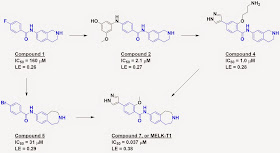Pan-assay interference compounds – PAINS – are a topic that
has come up repeatedly at Practical
Fragments (see here, here, and here for starters). Indeed, they form the basis
of our occasional (and controversial) “PAINS shaming” series (see here, here,
here, and here). In a paper recently published online in J. Med. Chem., HTSPains-master Mike Walters (University of
Minnesota) and collaborators at the Mayo Clinic College of Medicine and AstraZeneca
characterize several new classes of PAINS (also covered at In the Pipeline). I was honored with the invitation to
write a Viewpoint on the topic. Since both papers are open-access I’ll just
briefly touch on a few key points here.
First, one of the only critics of the PAINS concept is
concerned that PAINS were originally defined on the basis of their over-representation
as screening hits in one set of assays. The new paper goes beyond empiricism to
characterize mechanisms, which involve non-specific reactions with thiols. (The
“non-specific” aspect is key to their undesirability, as covalent drugs can be
quite attractive.)
Second, just as “not every clam will hurt you”, not every
molecule with a PAINS substructure will show activity in every assay. These
“structure-interference relationships” (SIR) can be mistaken for
“structure-activity relationships” (SAR), making PAINS all the more insidious.
The researchers explore some of the reasons for the observed SIR.
Third, one of the saddest parts of the new paper is a list
of dozens of references in the supplemental information in which PAINS were
reported as screening hits or probes. It’s a safe bet that most – if not all –
of these should be disregarded.
Finally, publishing this list of new PAINS will allow people
to steer clear of them. To borrow from Hippocrates: chemical space is big, life
is short. Why waste time working with chemotypes known to be pathological?



